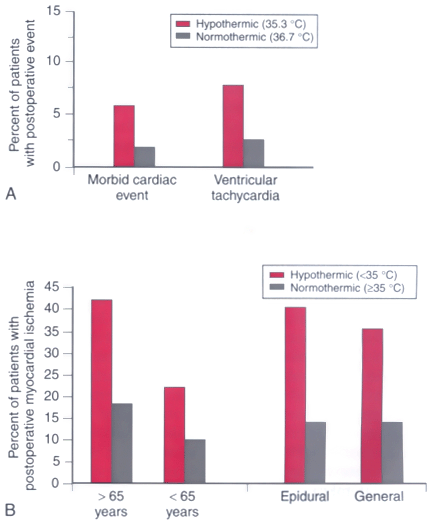 |
 |
Figure 52-21
A, Incidence of postoperative
cardiac morbidity for patients who were actively warmed with a forced-air system
(i.e., normothermic group) and those who received no warming (i.e., hypothermic group).
Morbid cardiac events (i.e., unstable angina, myocardial infarction, or cardiac
arrest) occurred more frequently in the hypothermic patients (P
= .03). Ventricular tachycardia and combined electrocardiographic or morbid events
also occurred more frequently in the hypothermic patients (P
= .04 and P = .001, respectively). B,
Incidence of myocardial ischemia after lower extremity vascular surgery by core temperature
on admission to the intensive care unit, anesthetic technique, and age. Patients
with temperatures below 35°C had a twofold to threefold greater incidence of
ischemia. Patients older than 65 years of age had a twofold greater incidence of
ischemia. (A, Adapted from Frank SM, Fleisher
LA, Breslow MJ, et al: Perioperative maintenance of normothermia reduces the incidence
of morbid cardiac events: A randomized clinical trial. JAMA 277:1127–1134,
1997; B, adapted from Frank SM, Beattie C, Christopherson
H, et al: Unintentional hypothermia is associated with postoperative myocardial
ischemia. The Perioperative Ischemia Randomized Anesthesia Trial Study Group. Anesthesiology
78:468–476, 1993.)

 |
